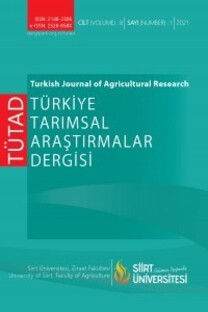Yabancı Ot Yoğunluğunun Silajlık Mısırın Büyümesine Etkileri: II. Kalite Özellikleri
Yabancı ot yoğunluğu, silajlık mısır, yem kalitesi, ham protein
Effects of Weeds Density on Growth of Silage Maize: II. Quality Characteristics
Weed density, silage maize, forage quality, crude protein,
___
- Abdelqader, M.M., Hippen, A.R., Kalscheur, K.F., Schingoethe, D.J., Garcia, A.D., 2009. Isolipidic additions of fat from corn germ, corn distillers grains, or corn oil in dairy cow diets. Journal of Dairy Science, 92(11): 5523-5533.
- Anonymous, 2011. Base SAS 9.3. SAS Institute Inc., Procedures Guide, NC.
- Azevedo, J.A.G., Valadares Filho, S.C., Pina, D.S., Valadares, R.F.D., Detmann, E., Paulino, M.F., Diniz, L.L., Fernandes, H.J., 2011. Intake, total digestibility, microbial protein production, and the nitrogen balance in ruminant diets based on agricultural and agro-industrial by-products. Arquivo Brasileiro de Medicana Veterinaria e Zootecnia, 63(1): 114-123.
- Butts, T.R., Miller, J.J., Pruitt, J.D., Vieira, B.C., Oliveira, M.C., Ramirez, S., Lindquist, J., 2017. Light quality effect on corn growth as influenced by weed species and nitrogen rate. Journal of Agricultural Science, 9(1): 15-27.
- Carvalho, L.P.F., Cabrita, A.R.J., Dewhurst, R.J., Vicente, T.E.J., Lopes, Z.M.C., Fonseca, A.J.M., 2006. Evaluation of palm kernel meal and corn distillers grains in corn silage-based diets for lactating dairy cows. Journal of Dairy Science, 89(7): 2705-2715.
- Heuze, V., Tran, G., Edouard, N., Lebas, F., 2017. Maize Silage. Feedipedia, a Programme by INRAE, CIRAD, AFZ and FAO. (https://www.feedipedia. org/node/13883), Last Updated on June 22.
- Ileri, O., Budaklı Carpıcı, E., Erbeyi, B., Avcı, S., Koc, A., 2018. Effect of sowing methods on silage yield and quality of some corn cultivars grown in second crop season under irrigated condition of central Anatolia, Turkey. Turkish Journal of Field Crops, 23(1): 72-79.
- Jensen, E.S., Nielsen, H.H., 2003. How can use of biological N2 fixation in agriculture benefit the environment? Plant and Soil, 252(1): 177-186.
- Karasahin, M., 2014. Effects of different irrigation methods and plant densities on silage quality parameters of PR 31Y43 hybrid corn cultivar (Zea mays L. var. indentata [Sturtev.] L.H. Bailey). Chilean Journal of Agricultural Research, 74(1): 105-110.
- Khan, N.A., Tewoldebrhan, T.A., Zom, R.L.G., Cone, J.W., Hendriks, W.H., 2012. Effect of corn silage harvest maturity and concentrate type on milk fatty acid composition of dairy cows. Journal of Dairy Science, 95(3): 1472-1483.
- Peichl, M., Thober, S., Samaniego, L., Hansjürgens, B., Marx, A., 2019. Climate impacts on long-term silage maize yield in Germany. Scientific Reports, 9: 7674.
- Rajcan, I., Swanton, C.J., 2001. Understanding maize-weed competition: Resource competition, light quality and the whole plant. Field Crop Research, 71(2): 139-150.
- Shrestha, J., Timsina, K.P., Subedi, S., Pokhrel, D., Chaudhary, A., 2019. Sustainable weed management in maize (Zea mays L.) production: A review in perspective of Southern Asia. Turkish Journal of Weed Science, 22(1): 133-143.
- Swanton, C.J., Weaver, S., Cowan, P., Van Acker, R., Deen, W., Shreshta, A., 1999. Weed thresholds: theory and applicability. Journal of Crop Production, 2(1): 9-29.
- Swanton, C.J., Weise, S.F., 1991. Integrated weed management: the rationale and approach. Weed Technology, 5(3): 657-663.
- Tursun, N., Sakınmaz, M.S., Kantarcı, Z., 2016. Mısır varyetelerinde yabancı ot kontrolü için kritik periyotların belirlenmesi. Tarla Bitkileri Merkez Araştırma Enstitüsü Dergisi, 25(Özel sayı-1): 58-63.
- Vazin, F., 2012. The effect of pigweed redroot (Amaranthus retoflexus) weed competition and its economic thresholds in corn (Zea mays L.). Planta Daninha, 30(3): 477-485.
- West, J.R., Ruark, M.D., Shelley, K.B., 2020. Sustainable intensification of corn silage cropping systems with winter rye. Agronomy for Sustainable Development, 40(2): 11.
- ISSN: 2148-2306
- Başlangıç: 2014
- Yayıncı: SİİRT ÜNİVERSİTESİ ZİRAAT FAKÜLTESİ
Coronavirus Disease (COVID-19): A Review of Antiviral Potential Herbal Medicines
Tuğsen DOĞRU, Fatma AYAZ, Nuraniye ERUYGUR
Sinop İlinde Çiftçilerin Sulama Yöntemleriyle İlgili Tercihleri
Gamze AYDIN ERYILMAZ, Osman KILIÇ, Coşkun GÜLSER
Güneydoğu Anadolu Bölgesi Pamuklarının Lif Kalite Özelliklerindeki Değişim Sınırlarının Belirlenmesi
Güncel Bir Bakış Açısıyla Poliaminlerin Bitki Büyüme ve Gelişimi Üzerine Etkileri
Halil DİLMEN, Cevdet KAPLAN, Mustafa Cemal ÇİFTÇİ, Suna ÇAKMAK
Klorürün Şeker Pancarı (Beta vulgaris L.) Verim ve Kalite Değerleri Üzerine Etkisi
Yabancı Ot Yoğunluğunun Silajlık Mısırın Büyümesine Etkileri: I. Bitkisel Özellikler
Şule ERKOVAN, Onur İLERİ, Halil İbrahim ERKOVAN, Ali KOÇ
A Study of Soil and Land Features with Geographic Information Systems (GIS) Analysis: Iğdır, Türkiye
Yabancı Ot Yoğunluğunun Silajlık Mısırın Büyümesine Etkileri: II. Kalite Özellikleri
Şule ERKOVAN, Onur İLERİ, Halil İbrahim ERKOVAN, Ali KOÇ
Tüketicilerin Gıda Güvenliği Bilinç Düzeylerini Etkileyen Faktörler: Samsun İli Örneği, Türkiye
